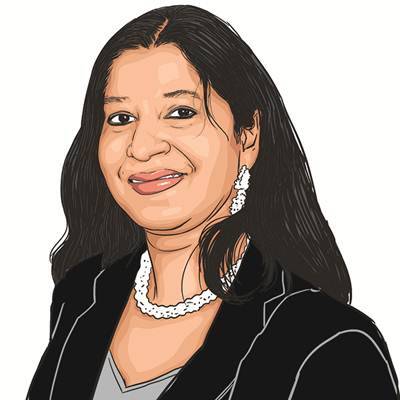Opinion Remembering C V Chandrasekhar: A dancer’s dancer
I contrast Chandrasekhar's sublime art to the ubiquitous razzle dazzle of today; and, to some of Bharatanatyam's prima donnas, who are profoundly restless and overdone. His grace will be missed
 C V Chandrasekhar. (Image source: Wikimedia Commons)
C V Chandrasekhar. (Image source: Wikimedia Commons) Professor C V Chandrasekhar (May 22, 1935-June 19, 2024) — Chandru Anna to us — was one of the last of the legendary greats who studied Bharatanatyam with Peria Sarada, Chinna Sarada, and Guru Dandayudhapani Pillai, in the Pandanallur style, at Chennai’s Kalakshetra during its founder Rukmini Devi’s time. He was, afterwards, a senior member of the faculty of Dance at Banaras Hindu University; and professor and head of the Dance department, and, then, dean of Fine Arts at M S University, Baroda, for a long period. He won the Sangeet Natak Akademi Award, the Padma Bhushan, and the Kalidas Samman. He was a student of music before he became a dancer; and that wellspring illuminated his art. A robust knowledge of music is imperative for classical Indian dance, and Chandrasekhar possessed way more than a fair share of it.
Chandrasekhar was blessed with a handsome and expressive face and a lean, tall frame. He was a dancer’s dancer: Eloquent, chiselled, poised, perfect, and moving. Bharatanatyam’s sitting posture is called the araimandi (or ardhamandali) and it is the mandatory base from which the dance grows, and strikes roots, branches and flowers. It is difficult, but compulsory, to maintain the araimandi through an entire recital — but it is alarmingly absent today. When you sit in the araimandi, and your feet are together, pointing out in opposite directions, at 180 degrees, and, consequently, you are at two-thirds of your height, you are doing Bharatanatyam in the classically prescribed way. Sitting any less, or having your feet not quite out, is cheating. Chandrasekhar sat much more — his araimandi was sustained, even at 85, and a sight for the gods.
In a full-blown traditional recital, or margam, performed at age 82 — with not a sliver of a concession to his age — Chandrasekhar started off with a crisp alarippu, breezing through, among the other classic repertoire pieces, the challenging varnam, all the way to the tillana in Natabhairavi. His abhinaya was most convincing, if subtle, as his face became the palette for a gamut of emotions. There was not a single moment in this recital which was not complete in itself; and not a single moment which you might have wished for in any other way. That is perfection, and it generates exhilarating rasawada.
Chandrasekhar’s costume, minimal jewellery, and no makeup, save an outline of the eyes, did justice to a prized aesthetic in which less is more. It is this Bharatanatyam which I love, and have practised since age six; and it is this Bharatanatyam which is never excessive, but, nevertheless, exuberant and brilliant, and contains complex multitudes. Bharatanatyam is a grand style: It integrates dance and music, sahitya, raga, bhava, and tala — in a repertoire of over a thousand pieces, and steadily growing — and it is the god Shiva’s dance, as well as his consort, Parvati’s. As you watched Chandrasekhar, it was Shiva’s dance which came to mind.
I contrast Chandrasekhar’s sublime art to the ubiquitous razzle dazzle of today; and, to some of Bharatanatyam’s prima donnas, who are profoundly restless and overdone: They flash repeated come-hither expressions, even as they do nritta, or pure dance pieces. Yamini Krishnamurti articulated being dismayed at this phenomenon to me, way back in 1981, when I spent two years in close proximity to her. Their costumes often resemble Christmas trees at Walmart. I also contrast his meditative and self-assured dance to the aggressive selfie-and-Instagram-addicted cadres who post inconsequential, narcissistic — and often plagiarised — dance clips of themselves, three times a day. Their live performances thus become an agglomeration of selfies, with a plethora of unappealing dazzle, “in a spirit of gluttony and bricolage”. They don’t possess a hint of the Yeatsian merging of the dancer and the dance, which you witness in Chandrasekhar.
I first met Chandrasekhar, together with his lovely wife, Jaya, a sought-after Bharatanatyam guru herself, in Varanasi, in September 1979, when I was first invited to dance there. My guru Kelucharan Mohapatra accompanied me on pakhawaj (he always did), and I gave a recital at the Nagri Natak Mandali. Chandrasekhar played the manjira for me at my concert because my guru asked him to. Think of the extreme good fortune of a rather young girl: Two great gurus simultaneously onstage, accompanying you at a recital. In my audience that evening were Pandit Kishan Maharaj, Pandita Girija Devi, Ustad Bismillah Khan, Pandit Chhannulal Mishra, professor Veer Bhadra Mishra, and other Varanasi legends.
The day after my recital, Chandrasekhar and Jaya Akka invited Guruji and me to their charming Varanasi home. We spent the better part of that day and the next day together. How precious those two days were, I always knew, but after Chandrasekhar’s passing, they seem even more so.
Gerard Manley Hopkins, a Jesuit poet, and a favourite, writes of the opposites which make for the miracle of divine creation: Whatever is “sweet-sour; swift-slow, adazzle-dim”. In tribute, I will always recall the inherent grandeur in Chandrasekhar’s art, which enabled him to create and easily juxtapose dichotomous emotions and tattwas (attributes), and reach into the deep recesses of our beings, creating within us, the spectator/rasika, a lilting and lasting harmony.
As the novelist Raja Rao said: “When movement is from oneself to the Self, one dances”. That Self is the divine: It is, verily, the universe.
Professor Chandrasekhar is survived by his wife, Jaya, and lovely dancer daughters, Chitra and Manjari.
The writer was appointed Distinguished Fellow at Carnegie Mellon University in 1990. She is also a global adviser on public policy, communications, and international relations and is an award-winning Odissi and Bharatanatyam artiste and choreographer






